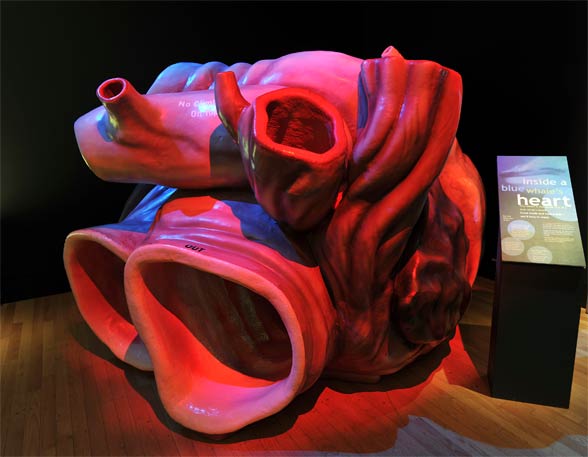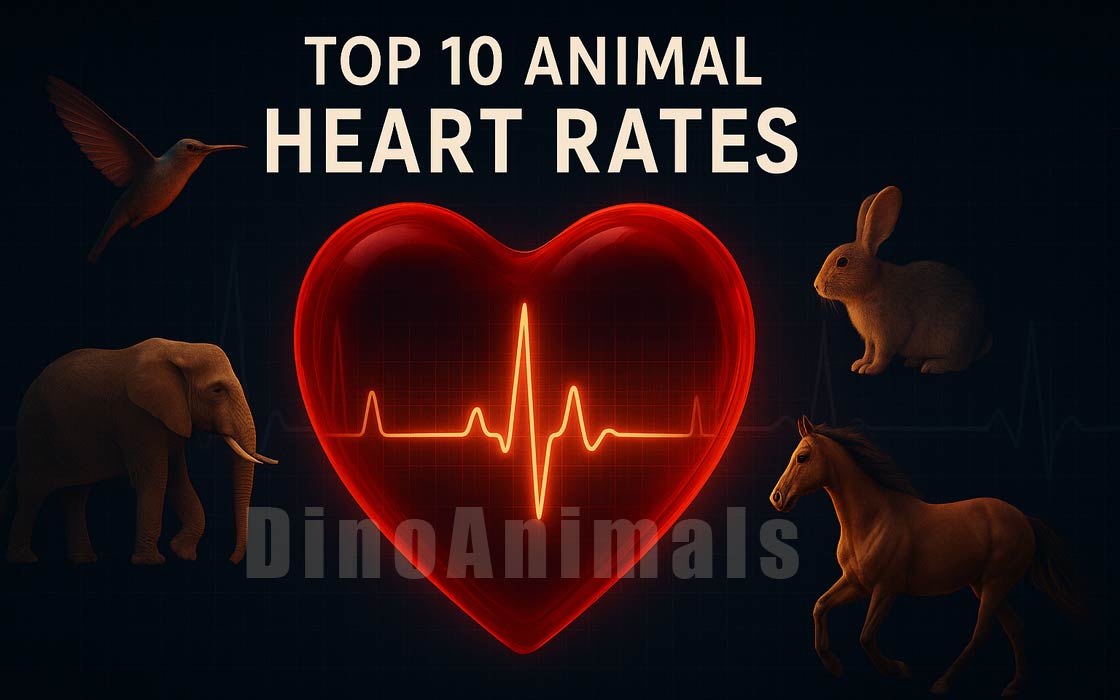Animal heart rate TOP 10
Hearts are symbols of Valentine’s Day, but in the animal kingdom, there are many different hearts – small, medium, and huge. The human heart beats about 60-80 times per minute. Our heart rate increases when we enhance our physical effort or when we get stressed.
As you might guess, the heart rate of most animals differs from the human pulse. A hibernating groundhog’s (Marmota monax) heart beats only 5 times per minute, while a hummingbird’s heart beats 1,260 bpm. Let us take a closer look at how fast hearts beat in the animal world.

Heart beats of animals per minute [Bpm]
- Hibernating groundhog 5
- Blue whale 8-10
- Tortoise 10
- Alligator 32
- Elephant 25–35
- Snake 20-40
- Horse 28–40
- Dolphins 35 – 45
- Bear 55 (14 during hibernation sleep)
- Ox 36–60
- Lion 50-60
- Condor 65
- Dairy cow 48–84
- Human 60 – 80 (average 72)*
- Dog large 60–80
- Goat 70–80
- Sheep 70–80
- Dog medium 80-100
- Pig 70–120
- Cat 120–140
- Cheetah up to 150 during run
- Dog small 100-160
- Pigeon 185
- Wild duck 190
- Turkey 193
- Parrot 200
- Domestic duck 240
- Rhesus monkey 160–330
- Guinea Pig 200–300
- Chicken (adult) 250–300
- Buzzard 300
- Hen 312
- Rabbit 180–350
- Crow 378
- Rat 250–400
- Chick 350–450
- Pigeon up to 600
- Hamster 300–600
- Mouse 450–750
- Canary 1,020
- Blue-throated Hummingbird 1,260
- Etruscan shrew 1,511

*Man resting heart rate varies with age:
- Fetal heart rate: 110-150
- Newborn’s and infant’s pulse:
- 0-3 months: 100-150
- 3-6 months: 90-120
- 6-12 months: 80-120
- Pulse of a child 1-10 years: 70-130
- Pulse of youth: 85
- Pulse of adult: 70
- Pulse of an elderly person: 60
- Pulse of professional athlete: 40-60; record – 27 beats (professional cyclist).
Heart rates of animals
The heart rate of animals varies depending on the species. For example, a human’s resting heart rate is typically around 60-80 beats per minute, while a horse’s resting heart rate is around 28-44 beats per minute. A dog’s resting heart rate is around 60-140 beats per minute. A lion’s heart rate is around 50-60 beats per minute, while a cheetah’s heart rate can reach up to 150 beats per minute during a chase. Birds have high heart rates compared to mammals, with a pigeon’s heart rate reaching up to 600 beats per minute during flight. Fish and reptiles have a lower heart rate than mammals. For example, a snake’s heart rate is around 20-40 beats per minute.
In addition to species, other factors can also affect an animal’s heart rate. For example, an animal’s heart rate will typically increase during periods of exercise or stress. Age can also play a role, as an older animal may have a slower heart rate than a younger one. Certain medical conditions can also affect an animal’s heart rate. For example, an animal with a heart condition may have a faster or slower heart rate than a healthy animal.
It’s important to note that heart rate is only one aspect of an animal’s cardiovascular health, and other factors such as blood pressure, cardiac output, and oxygenation should also be considered. Veterinarians use various tools such as ECG (electrocardiogram), an echocardiogram, and blood tests to examine an animal’s heart health.
How many hearts do animals have?
Most animals have only one heart. This includes mammals, birds, reptiles, and fish. The single heart pumps blood through the circulatory system, providing oxygen and nutrients to the body’s cells and removing waste products.
However, some animals have multiple hearts. For example, some invertebrates, such as octopuses and squid, have three hearts. An octopus has two gill hearts and one systemic heart. The gill hearts pump blood to the gills, while the systemic heart pumps blood to the rest of the body.
Similarly, some species of fish, such as lungfish and mudskippers, have two hearts. A lungfish has one heart for pumping blood to the gills and another heart for pumping blood to the rest of the body.
In addition, certain species of amphibians, such as the axolotl, have three hearts. They have two branchial hearts that pump blood to the gills and one systemic heart that pumps blood to the rest of the body.
Most animals have one heart, but some species of fish, amphibians, and invertebrates have multiple hearts.
How big are animal hearts?
The size of an animal’s heart can vary greatly depending on the species. In general, heart size is proportional to the size of the animal’s body.
For example, the heart of a small bird, such as a sparrow, is only about the size of a walnut, while the heart of a large bird, such as an ostrich, can weigh as much as 1.4 kg (3 pounds)
- In mammals, a human heart is about the size of a fist, while an elephant’s heart can weigh as much as 12–21 kg (26–46 lb).
- The heart of a lion is about the size of a human head, while the heart of a domestic cat is about the size of a lime.
- A blue whale’s heart can weigh as much as 199.5 kg (440 pounds) and is the largest heart of any animal.
It’s important to note that heart size is also related to an animal’s lifestyle. For example, animals that fly or swim need a stronger heart to pump more blood to their muscles.
In summary, the size of an animal’s heart can vary greatly depending on the species, but in general, it is proportional to the size of the animal’s body. Larger animals tend to have larger hearts.
Swift and sluggish heart rates in animals
Swift and sluggish heart rates in animals can be caused by a variety of factors.
Animals with swift heart rates typically have higher metabolisms, which allows them to generate more energy to fuel their activities. For example, animals that are built for speed and endurance, such as cheetahs, greyhounds, and hummingbirds, have high heart rates. A cheetah’s heart rate can reach up to 150 beats per minute during a chase, and a hummingbird’s heart rate can reach up to 1,260 beats per minute when hovering.
On the other hand, animals with sluggish heart rates typically have lower metabolisms. For example, animals that are built for efficiency and conservation of energy, such as sloths, pangolins, and koalas, have low heart rates. A sloth’s heart rate can be as low as 20 beats per minute, and a pangolin’s heart rate is around 15-20 beats per minute.
Other factors that can affect an animal’s heart rate include age, temperature, and stress. For example, young animals tend to have faster heart rates than older animals, and animals living in warm climates tend to have slower heart rates than animals living in cold climates. Stress can also cause an animal’s heart rate to increase.
What affects heart rate?
Heart rate, or pulse, is the number of times a heart beats per minute. It is affected by various factors, including:
- Physical activity: Exercise increases the demand for oxygen in the muscles, causing the heart to beat faster to pump more blood to the muscles.
- Hormonal changes: Hormones such as adrenaline and thyroid hormone can increase heart rate, while hormones such as parathyroid hormone can decrease heart rate.
- Emotions: Stress and anxiety can cause a temporary increase in heart rate.
- Body position: Moving from a lying down to a standing position can cause a temporary increase in heart rate.
- Medications: Some medications can affect heart rate, such as certain types of blood pressure medications and heart medications.
- Medical conditions: Some medical conditions can affect heart rate, such as anemia, hyperthyroidism, and some types of heart disease.
- Age: As people age, their heart rate tends to slow down
- Temperature: Changes in body temperature can affect heart rate. For example, being in a hot environment can cause an increase in heart rate, while being in a cold environment can cause a decrease in heart rate.
- Hibernation
It’s important to note that heart rate can vary from person to person and can also change throughout the day. A normal heart rate can range from 60 to 80 beats per minute at rest, but it can vary depending on different factors. A doctor should be consulted if you have concerns about your heart rate.


















